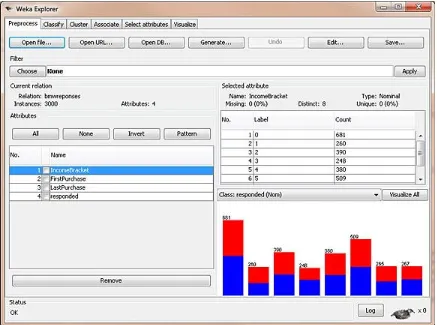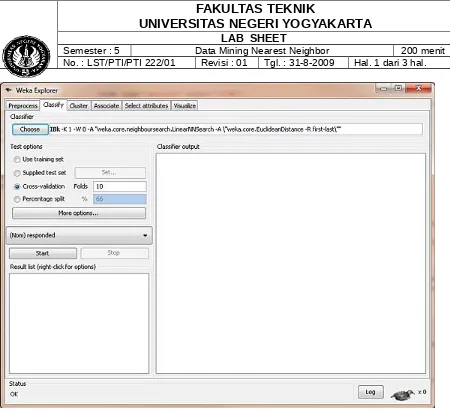Handaru Jati, Ph.D
Universitas Negeri Yogyakarta
[email protected]
Nearest Neighbor
Nearest Neighbor (also known as Collaborative Filtering or Instance-based Learning) is a useful data mining technique that allows you to use your past data instances, with known output values, to predict an unknown output value of a new data instance. So, at this point, this description should sound similar to both regression and classification. How is this different from those two? Well, first off, remember that regression can only be used for numerical outputs. That differentiates it from Nearest Neighbor immediately. Classification, as we saw from the example in the previous article, uses every data instance to create a tree, which we would traverse to find our answer. This can be a serious problem with some data. Think about a company like Amazon and the common "Customers who purchased X also purchased Y" feature. If Amazon were to create a classification tree, how many branches and nodes could it have? There are maybe a few hundred thousand products. How big would that tree be? How accurate do you think a tree that big would be? Even if you got to a single branch, you might be shocked to learn that it only has three products. Amazon's page likes to have 12 products on it to recommend to you. It's a bad data mining model for this data.
You'll find that Nearest Neighbor fixes all those problems in a very efficient manner, especially in the example used above for Amazon. It's not limited to any number of comparisons. It's as scalable for a 20-customer database as it is for a 20 million-customer database, and you can define the number of results you want to find. Seems like a great technique! It really is — and probably will be the most useful for anyone reading this who has an e-commerce store.
Let's delve into the math a little bit, so you can understand the process and also see some of the limitations of this technique.
Math behind Nearest Neighbor
Listing 1. Nearest Neighbor math
To answer the question "What is Customer No. 5 most likely to buy?" based on the Nearest Neighbor algorithm we ran through above, the answer would be a book. This is because the distance between Customer No. 5 and Customer No. 1 is less (far less, actually) than the distance between Customer No. 5 and any other customer. Based on this model, we say that the customer most like Customer No. 5 can predict the behavior of Customer No. 5.
However, the positives of Nearest Neighbor don't end there. The Nearest Neighbor algorithm can be expanded beyond the closest match to include any number of closest matches. These are termed "N-Nearest Neighbors" (for example, 3-Nearest Neighbors). Using the above example, if we want to know the two most likely products to be purchased by Customer No. 5, we would conclude that they are books and a DVD. Using the Amazon example from above, if they wanted to know the 12 products most likely to be purchased by a customer, they would want to run a 12-Nearest Neighbor algorithm (though Amazon actually runs something more complicated than just a simple 12-Nearest Neighbor algorithm).
The final question to consider is "How many neighbors should we use in our model?" Ah — not everything can be easy. You'll find that experimentation will be needed to determine the best number of neighbors to use. Also, if you are trying to predict the output of a column with a 0 or 1 value, you'd obviously want to select an odd number of neighbors, in order to break ties.
Data set for WEKA
The data set we'll use for our Nearest Neighbor example should look familiar — it's the same data set we used for our classification example in the previous article. It's about our fictional BMW dealership and the promotional campaign to sell a two-year extended warranty to past customers. To review the data set, here are the specifics I introduced in the last article.
There are 4,500 data points from past sales of extended warranties. The attributes in the data set are Income Bracket [0=$0-$30k, 1=$31k-$40k, 2=$41k-$60k, 3=$61k-$75k, 4=$76k-$100k, 5=$101k-$150k, 6=$151k-$500k, 7=$501k+], the year/month their first BMW was bought, the year/month the most recent BMW was bought, and whether they responded to the extended warranty offer in the past.
Why are we using the same data set we used in the classification example? Because, if you remember the results of that model, it was only 59-percent accurate, which wasn't acceptable at all (barely better than guessing). We're going to improve it and give this fictional dealership some useful information.
Figure 1. BMW Nearest Neighbor data in WEKA
Like we did with the regression and classification model in the previous articles, we should next select the Classify tab. On this tab, we should select lazy, then select IBk (the IB stands for Instance-Based, and the k allows us to specify the number of neighbors to examine).
At this point, we are ready to create our model in WEKA. Ensure that Use training set is selected so we use the data set we just loaded to create our model. Click Start and let WEKA run. Figure 3 shows a screenshot, and Listing 3 contains the output from this model.
Listing 3. Output of IBk calculations
=== Evaluation on training set === === Summary ===
Correctly Classified Instances 2663 88.7667 % Incorrectly Classified Instances 337 11.2333 % Kappa statistic 0.7748
Mean absolute error 0.1326 Root mean squared error 0.2573 Relative absolute error 26.522 % Root relative squared error 51.462 % Total Number of Instances 3000
=== Detailed Accuracy By Class ===
1
How does this compare with our results when we used classification to create a model? Well, this model using Nearest Neighbor has an 89-percent accuracy rating, while the previous model only had a 59-percent accuracy rating, so that's definitely a good start. Nearly a 90-percent accuracy rating would be very acceptable. Let's take this a step further and interpret the results in terms of false positives and false negatives, so you can see how the results from WEKA apply in a real business sense.
The results of the model say we have 76 false positives (2.5 percent), and we have 261 false negatives (8.7 percent). Remember a false positive, in this example, means that our model predicted the customer would buy an extended warranty and actually didn't, and a false negative means that our model predicted they wouldn't buy an extended warranty, and they actually did. Let's estimate that the flier the dealership sends out cost $3 each and that the extended warranty brings in $400 profit for the dealer. This model from a cost/benefit perspective to the dealership would be $400 - (2.5% * $3) - (8.7% * 400) = $365. So, the model looks rather profitable for the dealership. Compare that to the classification model, which had a cost/benefit of only $400 - (17.2% * $3) - (23.7% * $400) = $304, and you can see that using the right model offered a 20-percent increase in potential revenue for the dealership.
As an exercise for yourself, play with the number of nearest neighbors in the model (you do this by right-clicking on the text "IBk -K 1...." and you see a list of parameters). You can change the "KNN" (K-nearest neighbors) to be anything you want. You'll see in this example, that the accuracy of the model actually decreases with the inclusion of additional neighbors.
The final challenge with the Nearest Neighbor technique is that it has the potential to be a computing-expensive algorithm. In Amazon's case, with 20 million customers, each customer must be calculated against the other 20 million customers to find the nearest neighbors. First, if your business has 20 million customers, that's not technically a problem because you're likely rolling in money. Second, these types of computations are ideal for the cloud in that they can offloaded to dozens of computers to be run simultaneously, with a final comparison done at the end. (Google's MapReduce for example.) Third, in practice, it wouldn't be necessary to compare every customer in Amazon's database to myself if I'm only purchasing a book. The assumption can be made that I can be compared to only other bookbuyers to find the best match, narrowing the potential neighbors to a fraction of the entire database.
Remember: Data mining models aren't always simple input-output mechanisms — the data must be examined to determine the right model to choose, the input can be managed to reduce computing time, and the output must be analyzed and accurate before you are ready to put a stamp of approval on the entire thing.

